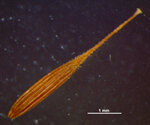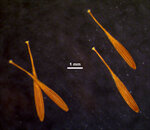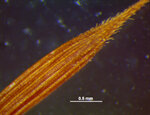Taxonomy
Crepis setosa Haller f., Arch. Bot. [Leipzig] 1(2): 1. 1797.Description
Propagule or dispersal unit is the fruit with pappus. Fertile part 2-4.5 mm long, 0.2-0.6 mm wide, in side view widest in lower part (ovoid) or widest in the middle, +/- straight or conspicuously curved, the upper (apical) end narrowing, in cross-section flattened, basal scar (carpopodium) inconspicuous and undifferentiated, central, beak (=thinner sterile stalk between seed and pappus) present, beak length 1-2.5 mm, wings absent, fruit surface light brown or straw, smooth (except at cellular level), with no hairs (glabrous), thickened margin absent, longitudinal ribs present, 8-13, their surfaces smooth or toothed, serrated or scale-like, with no hairs (glabrous) or papillae (small protuberances).
Pappus type bristles / hairs, pappus elements all +/- similar, up to 3.5-6 mm long, in several rows, pappus elements numerous, persistent or elements falling off individually, the individual bristles rough / serrated (barbellate), +/- equal width along length, white / translucent.
Notes: The surface of the longitudinal ribs has been scored to accommodate its interpetation as either toothed or carrying short conical hairs or papillae.
Ecology
Annual herb, fruits wind-dispersed although probably limited in distance due to easily losing the pappus. Temperate regions. Weed of disturbed areas, including open forests.
Native range
Europe.
Introduced range
United States, Uruguay, Chile, Argentina, Australia, New Zealand.
Weed status within Australia
WA Declared Pest s12 (C1 Prohibited).
Past interceptions (Australia): origins
Other or unidentified species of the genus from Canada, United Kingdom, Portugal, Spain, Netherlands, Germany, China, New Zealand.
Past interceptions (Australia): commodities
Other or unidentified species of the genus in/on sawn timer, containers, new vehicles, machinery and parts, seeds for sowing, personal effects, dried medicinal herbs.




